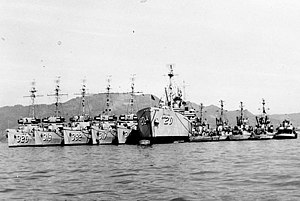| USS Gladiator (AM-319) | |
|---|---|
 USS Gladiator (second ship from left) at Sasebo, Japan, 1952. | |
| Career (United States) | |
| Name: | HMS Blaze (BAM-6) |
| Builder: | General Engineering & Dry Dock Company, Alameda, California |
| Laid down: | unknown |
| Renamed: | USS Gladiator (AM-319) |
| Launched: | 7 May 1943 |
| Sponsored by: | Mrs. Madeline A. Silva |
| Completed: | 25 February 1944 |
| Commissioned: | 25 February 1944 |
| Decommissioned: | 4 October 1946, San Diego, California |
| Recommissioned: | 29 February 1952, Long Beach, California |
| Reclassified: | MSF-319, 7 February 1955 |
| Decommissioned: | 15 March 1955, Long Beach, California |
| Struck: | 1 July 1972 |
| Homeport: | Long Beach, California |
| Honors and awards: | two battle stars for World War II service |
| Fate: | Sold to Mexico, 1973 |
| Career (Mexico) | |
| Name: | ARM Santos Degollado (C75) |
| Namesake: | José Santos Degollado |
| Acquired: | 1973 |
| Reclassified: | G07[1] |
USS Gladiator (AM-319) was an Auk-class minesweeper acquired by the U.S. Navy for the dangerous task of removing mines from minefields laid in the water to prevent ships from passing.
Construction history[]
Gladiator was originally built as BAM-6, and was launched 7 May 1943 as AM-319 by the General Engineering & Drydock Co., Alameda, California; sponsored by Mrs. Madeline A. Silva; and acquired and simultaneously commissioned 25 February 1944, Lt. Comdr. Robert W. Costello in command.
World War II service[]
Gladiator sailed from San Francisco, California, 1 May 1944 with a convoy for Pearl Harbor and subsequently made four round trip escort voyages from Hawaii—one to Kwajalein and three to Eniwetok—from 22 May-11 September 1944. Underway again 16 October, she reached Ulithi 12 November and commenced patrol and escort duty in those waters. Voyages to Eniwetok, Kossol Roads, and Saipan, were frequently made to shepherd merchantmen to and from those strategic ports until Gladiator sailed from Ulithi 19 March 1945 for combat at Okinawa.
Closing the beaches of Okinawa 24 March when Vice Admiral Willis A. Lee’ s battleships were bombarding the island, Gladiator began minesweeping operations and screening duties.
Under attack by Japanese aircraft[]
On 6 April she came under attack from a Japanese bomber and shot it down with the help of four American fighters that were on the bomber's tail during its approach. Another plane was splashed 6 days later when Gladiator's automatic weapons brought it down close aboard on the starboard beam; debris rained about the ship. A third enemy plane was shot down 22 April, crashing into the sea after passing just fifty feet above the ship's deck; but one man was killed and five wounded by the plane's strafing. Gladiator continued minesweeping duties off Okinawa until sailing 19 May with a convoy for Saipan and Guam, subsequently returning to Okinawa 21 June. From 8–25 July 1945 she conducted minesweeping operations in the East China Sea, destroying six mines, and put in at Guam 11 August for major overhaul.
End-of-war operations[]
Gladiator departed Guam 24 November and reached San Francisco, California, 15 December 1945. She steamed to San Pedro, California, 30 May 1946, and, after being towed to San Diego, California, 2 October 1946 she was decommissioned at that port 2 days later.
Korean War service[]
Recommissioned 29 February 1952 at Long Beach, California, Gladiator sailed 2 September for Japan, closing Sasebo 1 month later, and steaming to Wonsan, Korea, 27 October. She swept mines in those dangerous waters until returning to Sasebo 10 November and subsequently, until the spring of 1953, divided her time between mine-sweeping operations at Wonsan, Inchon, and Hungnam and replenishment and training exercises in Sasebo and Yokosuka, Japan.
Post-Korean War activity[]
Gladiator departed Sasebo, Japan, 19 March 1953 and put in at Long Beach, California, 10 April. She engaged in peacetime activities: overhaul at San Francisco, training exercises off southern California, a round trip cruise from Long Beach to Acapulco, Mexico, and Balboa, Panama (15 January-12 February 1954), and a cruise to Bellingham, Washington, and return (28 June-10 July 1954).
Decommissioning and disposal[]
Gladiator was decommissioned at Long Beach, California, on 15 March 1955. Redesignated MSF-319, Gladiator entered the reserve fleet berthed at Green Cove Springs, Florida. She was later transferred to the Pacific Reserve Fleet at San Diego, California. She remained in "mothballs" until 1973, when she was sold to Mexico and renamed Santos Delgollado.
Battle honors[]
Gladiator received two battle stars for World War II service.
[]
The former Gladiator was sold in 1973 to the Mexican Navy, which renamed her ARM Santos Delgollado (C75). Her pennant number was later changed to G07, before it was changed a final time to P106 in 1993. As of 2015[update], Santos Delgollado was in active service with the Mexican Navy.[1]
Notes[]
- ↑ 1.0 1.1 Wertheim, Eric, ed (2007). The Naval Institute Guide to Combat Fleets of the World: Their Ships, Aircraft, and Systems (15th ed.). Annapolis, Maryland: Naval Institute Press. p. 472. ISBN 978-1-59114-955-2. OCLC 140283156.
References[]
- This article incorporates text from the public domain Dictionary of American Naval Fighting Ships. The entry can be found here.
- NavSource Online Gladiator (MSF 319)
- USS Gladiator (AM-319, later MSF-319), 1944-1973
External links[]
- Ships of the U.S. Navy, 1940-1945 AM-319 USS Gladiator
- Welcome To The Mine Sweeper USS Gladiator (AM-319)
- USS Gladiator (AM 319)
| ||||||||||||||||||||||||||||||||||||||||||||||||||||||||||||||||||||||
The original article can be found at USS Gladiator (AM-319) and the edit history here.